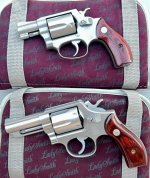- Joined
- Feb 9, 2006
- Messages
- 3,571
- Reaction score
- 6,341
Last month I did something dangerous. I navigated to a gun auction site that frequently includes police seizures and former LE sidearms and scrolled through the revolvers. There, for what seemed like a very reasonable price, was a Model 60 with rosewood magnas. It also had visible scratches down both sides of the frame. On the premise that "that'll polish out" I bid and won. Shipping time, the receiving FFL's schedule and my travel meant that it was around a week before I was able to examine it in hand.


Sure enough the scratches seemed superficial. It looked like someone had scraped the frame with a screwdriver. While the salesman was processing the paperwork I checked the bore. It was caked with something. So were the chambers. There was a layer of fine rust on the hammer and trigger. The scratches alone would have been enough to turn me away on a blued gun, even without the rust and gunk. But stainless holds up better and I am not superstitious. Our enlightened overlords in Springfield are concerned that I might do something rash with this gun that I wouldn't with the one in my pocket at the time, so back it went behind the counter. The FFL's schedule and a holiday weekend meant I had to pick it up 4 days later.
Once home I removed the grips and placed it in a cake pan full of hydrogen peroxide. It bubbled for two days, but after that a few strokes with a bore brush revealed unmarred bore and chambers. I let it air dry and took a few swipes with a Scotchbrite pad, which polished out most of the scratches and also reduced the "Ladysmith" marking to a faint hint of its former glory. I guess that makes it a ghost gun.
Back in the pan, this time with a 50-50 acetone/ATF mixture for three more days. Out of the bath and hosed down with Gunscrubber the sideplate screws backed out easily. There was a film of rust over the insides, but only the hammer, trigger and the very base of the hand required more than a light application of a brass brush or brass wool to clean up. An old .22 bore brush and dental picks topped by Kroil-soaked patches and a generous application of elbow grease had most of the stuff out within a half hour.
The case colors began to emerge from the patina on the hammer and trigger but additional soaking in Kroil and attention from some brass wool was needed to get all the caked-on crud out of the nooks and crannies. The hammer has some pits on the left side and I may replace it for cosmetics' sake. Function was unaffected.


I'm not as big a fan of stainless guns as is Mrs. Buford but this shiny thing may have a new home inside my waistband or in a Roy Baker pancake.


Sure enough the scratches seemed superficial. It looked like someone had scraped the frame with a screwdriver. While the salesman was processing the paperwork I checked the bore. It was caked with something. So were the chambers. There was a layer of fine rust on the hammer and trigger. The scratches alone would have been enough to turn me away on a blued gun, even without the rust and gunk. But stainless holds up better and I am not superstitious. Our enlightened overlords in Springfield are concerned that I might do something rash with this gun that I wouldn't with the one in my pocket at the time, so back it went behind the counter. The FFL's schedule and a holiday weekend meant I had to pick it up 4 days later.
Once home I removed the grips and placed it in a cake pan full of hydrogen peroxide. It bubbled for two days, but after that a few strokes with a bore brush revealed unmarred bore and chambers. I let it air dry and took a few swipes with a Scotchbrite pad, which polished out most of the scratches and also reduced the "Ladysmith" marking to a faint hint of its former glory. I guess that makes it a ghost gun.
Back in the pan, this time with a 50-50 acetone/ATF mixture for three more days. Out of the bath and hosed down with Gunscrubber the sideplate screws backed out easily. There was a film of rust over the insides, but only the hammer, trigger and the very base of the hand required more than a light application of a brass brush or brass wool to clean up. An old .22 bore brush and dental picks topped by Kroil-soaked patches and a generous application of elbow grease had most of the stuff out within a half hour.
The case colors began to emerge from the patina on the hammer and trigger but additional soaking in Kroil and attention from some brass wool was needed to get all the caked-on crud out of the nooks and crannies. The hammer has some pits on the left side and I may replace it for cosmetics' sake. Function was unaffected.


I'm not as big a fan of stainless guns as is Mrs. Buford but this shiny thing may have a new home inside my waistband or in a Roy Baker pancake.
Last edited:

